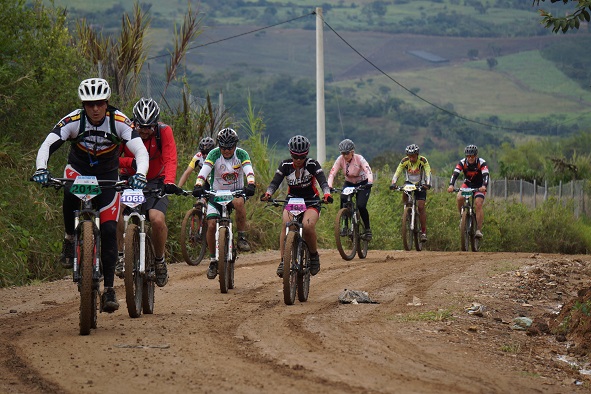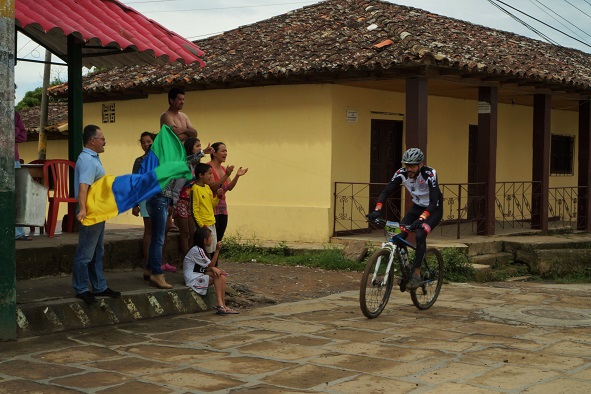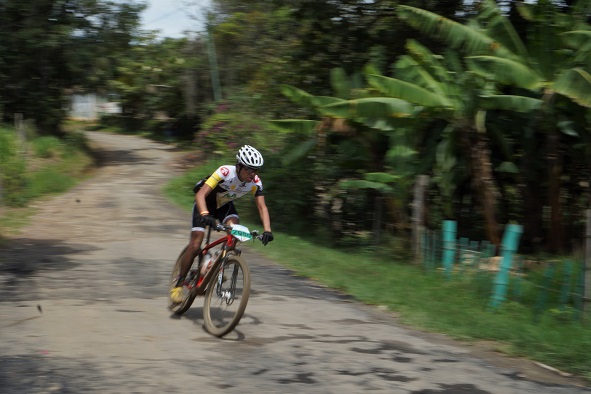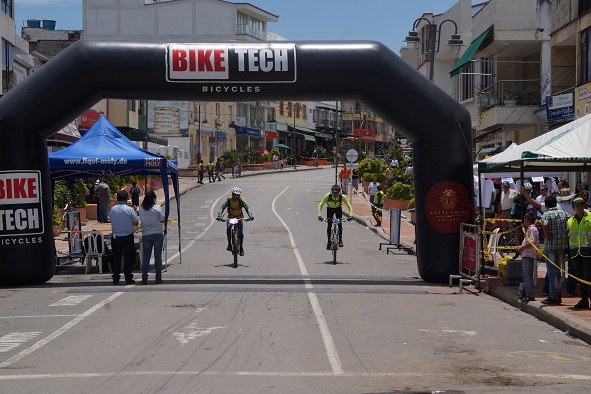Cycling in Colombia has for a long time thrilled locals and adventure-seeking travellers. Now, its rugged cousin is on the rise. The Andes Epic mountain bike race brings amateurs and some of the countries burgeoning superstars together in a testing high-altitude event. The three-day adventure heads up towering Andean peaks, down dizzying descents and through traditional villages lined with locals cheering riders to the chequered flag.

The long, hard push back to Barbosa (Photo: Simon Willis)
Sheathed in spandex, lean and primed, the hordes of Colombian cyclists await the gun. I push my bike along this Andean town’s street. I pass men and women wearing slick shades, chewing gum, flexing their necks, and lurching over their bikes like horses at the start of the Grand National. You can taste the adrenalin.
I walk on, eventually ducking under the tape at the rear. A rolling sea of multi-coloured cyclists lies ahead of me. The loudspeaker crackles, then a whine. The announcer shouts a few words in Spanish, encouraging huge cheers and whistles, then a hush. “Tres…Dos…Uno…Vamos!”
I registered for the Andes Epic in April, a month before the start. This three-day mountain bike race winds up the Eastern part of the Andean mountain range that runs through Colombia. Despite not hopping onto a mountain bike saddle since a family holiday in southern France 15 years ago, I find myself among a crowd of 550, mostly Colombian and mostly expert riders.
The journey will begin and end in Barbosa, a rural town lying 118 miles north of the country’s capital Bogotá. The front speedsters will chase the chequered flag; I’ll ride with a few amateurs at the back. While this type of everybody-welcome rural bike race isn’t a new phenomenon in Colombia, recently a glut of events has emerged. Always eager to test a trend, I’ve slipped, for the first time ever, into some lycra and joined the field.
Clicking and whirring pierce the early-morning sultry air as everyone shifts to the correct gear. In the distance, the pros are already scampering down the hill like ladybirds. Our group steadily edges forward. We pass women holding waving children and white-aproned street vendors wafting pieces of cardboard over BBQs. The smoke billows into my face and a beef taste awakens my saliva glands. We roll underneath a huge banner advertising Bocadillo (a sugared guava jelly made locally), stream past a police cordon and leave the last few cheers behind. The sun intensifies. Puffing and panting erupt all around like I’m in the middle of a marauding herd of cows. The town recedes into the distance. We’re now alone, heading deep into the rugged, luxuriant Andes Mountains.

Locals emerge to offer much-needed encouragement (Photo: Simon Willis)
Road Cycling v Off Road
Biking has always been popular in Colombia, but rather than the off-road version, it’s the slick, thin-wheeled activity that has traditionally led the line. In the 80s, road cyclists like Luis Alberto “Lucho” Herrera and Fabio Parra became Colombian heroes with their exploits on the European tours. Their successes encouraged locals to take up the freewheeling activity. Nowadays, Nairo Quintana’s glittering career is inspiring a new generation. Every week the streets of Bogotá, Medellín, and Cali sparkle with brightly-coloured cyclists enjoying the car-free event Ciclovía. Each Sunday in Bogotá alone, 75 miles of the streets close for riders, runners, skaters, joggers and the odd unicyclist. While joining the moving mass is an ideal way to see each city, opportunities to explore the countryside with a group of mountain bikers has been a rarity, until recently.
The Travesia Tairona race emerged in 2013 and takes riders from Sierra Nevada de Santa Marta’s jungle down to its Caribbean beaches. Tatacoa Desert race began in 2014, bumping cyclists along 62 miles of cacti-laden terrain in Huila – a region in Colombia’s south. And among the recent arrivals is La Leyenda Del Dorado (the legend of El Dorado). This race lasts seven days, passes through 19 towns and covers over 400 miles. I, however, chose the Andes Epic. Despite falling off the radar four years ago due to lack of interest, this race returned in 2015 and allows out-of-shape amateurs like myself to ride with the elite.
Most of the 31-mile trail snakes along pebbled paths, splashing into terracotta-coloured ditches and over crumbling rocks. Emerging at one of the many peaks (some reach 6,500 feet), I scan endless rows of guava plantations bursting from the shimmering sage-green mountainsides. As the group disperses, I’m left with the sound of my own breathing, the chirping of swooping birds and the swish, swish of local farmers scything down sugarcane plants with machetes.
On juddering descents, I brush past towering banana leaves. Lined outside bubblegum-hued colonial fincas (farm houses), cheery locals clap me along. One elderly woman even hands me a plastic cup of cool lemonade. “ánimo” (keep going) she says.

Many of the descents pass farms, towns and banana plantations (Photo: Simon Willis)
The Last Push
Colombia has always celebrated the achievements of its sports stars, especially cyclists, with incredible verve. In 1984 when “Lucho” won Colombia’s first ever stage of the Tour de France, the country erupted with elation, tears were shed among local journalists and his achievement is still talked about today.
After five hours, several lengthy climbs, two stops to devour bananas, guava jelly, and sweet cake, I re-enter Barbosa. A faint cheer drifts down the last ascent. Emerging from the final hilltop, a crowd of people bounce flags, wave balloons and yell “Vamos, Vamos.” They must have witnessed hundreds of cyclists today, I ponder, yet their enthusiasm is if I were “Lucho” or Quintana heading for victory.
A deeply wrinkled man wearing a vueltiao (traditional Colombian sombrero) leans over to clap my progress. Three young boys in faded yellow Colombian football jerseys run alongside me on the sidewalk. Opposite, a woman in a bright pink ‘princess’ top smiles and shouts “Puede hacerlo,” (you can do it).
The affection causes me to grin like a schoolboy who’s just received a glowing review at parents’ evening. If it weren’t for the fear of collapsing in a delirious heap, I would race through the finishing tape with both arms held aloft.
Having lived in Colombia for five years, I’ve seen its international appeal steadily grow. More than ever, travellers are exploring its magnificent Caribbean beaches, colonial towns, and pulsating cities. Saddling up and exploring the countryside, however, offers something new: A step into the unknown. Factor in a competitive element, the chance to ride alongside some of the country’s most promising racers and a big shiny medal at the end of it, and it’s hard to imagine a better way to explore Colombia’s rural side.

Riders still arrive nine hours after the starting gun (Photo: Simon Willis)